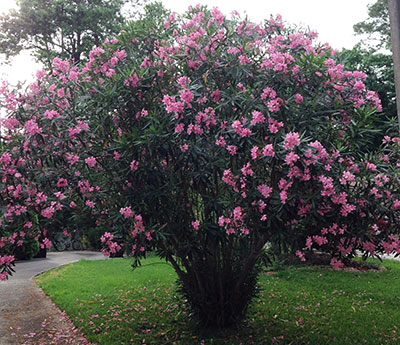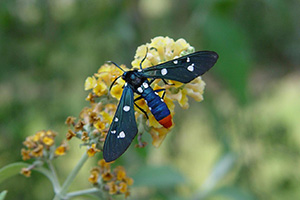Oleander
Oleander (Nerium oleander) may have a bit of a bad-girl reputation, but it is a truly beautiful addition to the Florida landscape.

While it’s true that all parts of the plant are toxic if ingested, you can still enjoy oleander. Just choose a spot in your yard that is away from small children and curious pets.
Nevertheless, oleander is well loved because it’s fast growing, has beautiful flowers, and can grow in a broad range of soils. It’s so easy to care for, you’ll find it planted alongside highways and interstates throughout Florida, where it handles heat and car exhaust admirably.
It’s tolerant of sea spray, and thus makes a colorful addition to the beachside landscape. There are even varieties with fragrant flowers. Oleander thrives throughout much of Florida, so gardeners across the state can enjoy this evergreen beauty.
Characteristics
Oleander is a member of the Apocynaceae family, along with star jasmine and periwinkle. It’s native to northern Africa and the eastern Mediterranean. This fast-growing evergreen shrub or small tree can be used in your garden as a living screen or wall. With pruning, oleander can be kept at a shrub height, or it can be trained into a small tree reaching between 10 and 18 feet tall. Shrubs will form a mounded shape up to 10 feet wide. There are dwarf cultivars, like ‘Petite Pink’ and ‘Petite Salmon’, reaching 4 feet in height that will work well in smaller spaces without pruning.
Oleander has long, dark green leaves and blooms throughout much of the year, especially in warm months. The bright flowers come in shades of white, pink, red, coral, or yellow, depending on the variety. The white flowers are especially bright and will pop in the landscape. There are varieties with single blossoms and double blossoms. Single flowers usually drop cleanly, while spent double flowers may linger unattractively on the plant. However, it’s the double-flower oleanders that tend to be fragrant. You’ll most likely find oleanders for sale by color, rather than by a variety name.
Planting and Care
While its slender leaves and dainty flowers give the plant a delicate look, oleander is low maintenance. It will grow in USDA Hardiness Zones 9a through 11, although frost will damage plants in North Florida. It will grow in the poorest of soils and is even drought tolerant; oleander even does well in areas with moderate sea spray.
Oleanders do best in full sun but will tolerate partial shade; too little light will cause the plant to get a leggy, open look and reduces flowering. If you’re looking to create a “green wall” with your oleander plants, they should be planted at 5 to 7 foot intervals.
To maintain a tree form, be sure to remove suckers that will grow at the base of the plant. Some gardeners severely prune plants in early to late fall to stimulate new growth. Since oleanders bloom on new wood, this can stimulate flowering, but fall pruning isn’t necessary. Regularly removing dead, damaged, or infested branches can improve plant health.
Oleanders are very drought tolerant and will do fine without supplemental watering, but during the hottest or driest parts of the year, a little watering will help your oleander thrive. Avoid overwatering and try to water the roots, not the leaves.
Pests or Problems

Anne W. Gideon, Bugwood.org
Although the toxic properties of oleander protect it against certain enemies like deer, it’s not without vulnerabilities. Disease-wise, it can become infected with Sphaeropsis gall, which usually becomes apparent with a proliferation of shoots and branches arising from diseased portions of branches (a “witches broom” effect). If this happens, prune branches at least 6 inches below where symptoms are seen. Prune back further if any discoloration from the fungal growth in the wood is noticed in the cut stem.
It is also susceptible to false oleander scale, aphids, and most damaging, oleander caterpillars. The colorful oleander moth (sometimes called the “polka-dot wasp moth” or “Uncle Sam moth”) lays its eggs on new leaves at the branch tips, where the larvae will feed. Oleander caterpillars can inflict serious chewing damage if left unchecked; they can completely defoliate a plant in as little as a week.
If you find oleander caterpillars, it’s not too late. Removing larvae-infested foliage is the most environmentally friendly method of control. Oleander sap can cause skin and eye irritation, so be sure to wash your hands immediately after touching any cuttings, or better yet, wear disposable gloves while pruning. Hand-pick the non-stinging caterpillars or cut off damaged foliage and the larvae feeding on it. Young caterpillars only scrape the leaf tissue, so this initial damage is easy to spot and can help cut short a full-on infestation. Put caterpillars (or the plant matter covered with them) in a plastic bag and freeze for 24 hours to kill the pests.

Mature caterpillars often migrate up walls of nearby buildings and pupate near the eaves. Removing these cocoons can help manage the next generation of this pest.
A Word of Caution
It’s important to note again that oleanders contain a naturally occurring toxin (cardenolide glycosides) that, when ingested in certain quantities, can be harmful—even fatal—to humans and pets. If an individual comes in contact with any poisonous materials, contact your local Poison Control Center immediately. Learn more from UF Health.
Due to this, using oleander in a landscape should be carefully considered. Parents should avoid planting oleander in their home landscape where there is a potential for small children to consume parts of this plant. When disposing of pruned branches, don’t burn them; the toxins will become airborne and may cause respiratory difficulties if the smoke is inhaled. Pet owners and livestock producers also are cautioned to place this plant out of the reach of animals who may graze on it. But don’t let this stop you from growing this beautiful and tough, low-maintenance shrub if you have the appropriate landscape for it.
For more information on growing oleander, contact your county Extension office.
